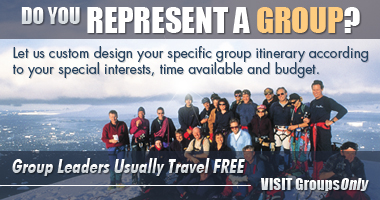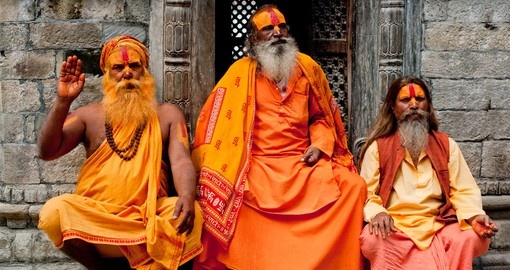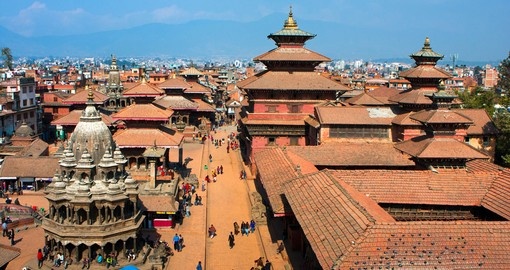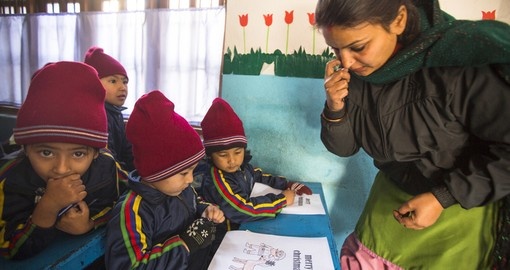Trekking in Nepal
NEPAL is a life-dream for the lover of adventures in the world, which lies at 26°12" to 30° 27" northern latitude and 80° 04" to 88° 12" eastern longitude on the global map. It has diversity in geography, culture, religion, climate, ethnic people, flora and fauna. Nepal is a landlocked country between India in the south, east and west and the Tibetan autonomous region of China in the north. The country is rectangular in shape stretching from east to west. The northern strip is the Himalayas (Mountainous) region, which includes eight of the ten highest mountains in the world.
TREKKING GENERAL INFORMATION
The Nepal Himalaya has always been known as “The abode of the Gods”. Many of the primordial history religion, culture and tradition as well as legends and myths emanate from the awesome Himalayas. The Nepal Himalayas harbours many holy temples and shrines, monasteries and sacred lakes in the wilderness and remote parts of the region. Pilgrims frequently visit these sites. It is a land of piety and stillness. The Himalayas is the youngest and highest mountain chain on earth. A full third of its stretches – the formidable Great Himalayan range of 800 kilometres lies within the Nepal Himalaya. It has a convergence of 1310 magnificent peaks over 6,000 meters, including eight of the world's highest 14 peaks of 8000 meters.
Nestling in the rain shadows of these unique vistas of soaring summits unravel profusion of lofty foothills, the home of the many Nepalese who delight in warm hospitality and friendship. These verdant terraced hills meander down to lush green valleys with turbulent rivers and to the tropical lowland and jungles teeming with countless wildlife. In its immensely diverse and undulating topography, varied climate and mix of people Nepal combines to produce a magical attraction for outsiders. Many foreign visitors come to trek one or more beautiful trekking regions. To trek, one does not have to be bizarre, neither a mountaineer nor an athlete. Anyone with a pair of strong legs, and the spirit for adventure to explore the exotic, will enjoy the thrills of trekking in the hills of Nepal. Walking in the interior of the country follows ancient foot trails, which meander through the scenic riverbanks, intricately terraced fields and the forested ridges connecting picturesque hamlets and mountain villages. These highly developed and well-defined trails have been used for centuries and are the hive of activities to encounter the locals.
For visitors on an extended holiday and with fewer restraints, there is an even more varied spectrum of adventure – be it rafting on the sparking rivers, safaris in the jungles, or trekking to explore deeper into the alpine valley with perpetual snow and glistening glaciers. The more intrepid traveler may venture further up to scale any of the 18 minor trekking peaks.
TREKKING SEASON
Trekking in Nepal can be undertaken throughout the year. There are four seasons related to trekking in Nepal. Each season has its distinct attraction to offer. The seasons are classified as follows:
AUTUMN (SEPT/ OCT/ NOV)
This season offers excellent weather and tantalizing mountain views.
WINTER (DEC/ JAN/ FEB)
This season is noted for occasional snowfall only at higher elevations. Hence, it is ideal for trekking at lower elevations, generally below 3000 meters.
SPRING (MAR/ APR/ MAY)
Different varieties of wildflowers, especially the rhododendrons make the hillside above 5000 meters a haunting paradise during this season. It is mildly warm at lower elevations, at higher elevations over 4000 meters the Mountain View is excellent, and the temperature is quite moderate.
SUMMER (JUN/ JUL/ AUG)
Summer months continue up to mid-September making travel wet and warm. These times are blessed for the keen botanist as the higher valleys and meadows blossom with flowers and lush vegetation. It is recommended to carry insect repellent when trekking during the summer months.
LIST OF CLOTHING EQUIPMENT AND PERSONAL EFFECTS
LIGHTWEIGHT WALKING BOOTS.
If a new one is being bought, “Walk them in” to avoid blisters. Also, bring spare laces.
A PAIR OF TRACKSHOES.
To wear in the camp at night or when the boot is wet
WARM JACKET.
Gore-Tex or Fiberfill or down should be adequate. This is especially necessary during winter from December to February.
A RAINPROOF JACKET WITH HOOD OR A PUNCHO.
Get the one that is guaranteed waterproof.
WOOLEN SHIRTS AND THICK SWEATER.
During winter months- December through February. These items are essential. Thick sweaters can be purchased in Kathmandu also.
A PAIR OF LIGHTWEIGHT/HEAVY TROUSERS.
Jeans are unsuitable to wear on treks. Cheap loose cotton pants are also available in Kathmandu. Heavyweight trousers are useful higher up in the mountains in the morning and at night. Windproof/ waterproof trousers are necessary on all treks going above 10000 ft.
THERMAL UNDERWEAR.
These are excellent to sleep in at night. In the winter month, thermal underwear is quite invaluable.
A TRACKSUIT.
Useful for wearing in camp and in the tent
2 PAIR OF LOOSE FITTING LONG SHORTS/SKIRTS.
2 COTTON T-SHIRTS.
1 LIGHTWEIGHT LONG SLEEVED-SHIRT
Is particularly suitable for avoiding sunburn.
A WOOLEN/ SUN HAT
To wear in the morning and at night. During winter, it is an essential item. A sunhat and ensure it has a wide brim to cover the face and neck.
A PAIR OF GLOVES.
Leather with lining and woollen are the best.
1 PAIR OF SANDALS
For wearing in the cities and in campsites
1 PAIR OF THICK AND 2 PAIR OF THICK WOOLEN SOCKS.
UNDERGARMENT.
Normal quantity.
DUFFLE BAG OR KIT BAG
To carry the gear while trekking.
DAY PACK.
This is a small rucksack to carry personal requirements for the day e.g. toilet items, camera, film, towel etc.
WATER - BOTTLE
SNOW GLASSES AND SUNGLASSES
2-4 LARGE PLASTIC BAGS
For separating clean clothes from dirty ones. 6-10 smaller plastic bags to dispose of garbage.
WALLET AND/OR MONEY BELT WITH COMPARTMENT.
TOILETRIES
With large and small towels
SMALL HEADLAMP AND /OR TORCH LIGHT
With spare batteries and bulbs, candles and a lighter to burn toilet paper.
SNOW GAITER
Essential during winter and all treks going over at other times
AN UMBRELLA (OPTIONAL)
Which is quite useful to ward off the dogs, suitable as a walking stick, to use as a sunshade and useful when it rains.
READING MATERIALS, CAMERA AND FILM, GAME ITEMS (OPTIONAL), NOTEBOOK, RUBBER BAND, PEN AND PENCIL ENVELOPES, A DIARY, A CALENDAR, A POCKET KNIFE, BINOCULARS (OPTIONAL), A SMALL PILLOW OR HEADREST (OPTIONAL), PERSONAL MEDICAL SUPPLIES.
CLASSIFICATION OF TREKKING
Trekking in Nepal takes you through the country that has captured the imagination of mountaineers and explores for over 100 years. You will encounter people in remote mountain villages whose lifestyle has not changed in generations, yet they will convey the trust of foreigners, which is made possible by their secure position as Nepal, is the only country in the world that has never been ruled by any foreign power. Trekking in Nepal will have an opportunity to observe a great variety of the Kingdom and the villages that embrace ethnic groups and cultures, accompanied by picturesque villages, beautiful terraced landscapes and majestic snow-capped mountains.
In order to provide an idea of the trekking standards, here are some general information and classification of the Himalayan trek:
GRADE I:
Generally between (900 to 2000 m.) with lots of “ups & downs”, one should be physically fit and a good walker for this trek.
GRADE II:
Varies between (900 to 3000 m.) a moderate trek with the possibility of side trips to higher elevations.
GRADE III:
A demanding trek, at an altitude of around 4000m with possible side trips to higher elevations. Remote & unpopulated mountain trails are involved.
GRADE IV:
It is considered a demanding trek reaching up to 5500 m. That requires excellent health and physically fit conditions.
ALPINE:
This category may include climbing trekking peaks and trekking through remote areas on rough terrain, therefore, it is considered as an extremely demanding trek. The trekker should have at least minimum experience of ALPINE TREK with basic knowledge of using crampons and an ice axe. A medical certificate from a qualified doctor is needed before winding this trek.
We are presenting here some information about the most interesting and popular trekking areas.
ANNAPURNA is the most popular trek in Nepal, which passes through some of the most stunning scenery on earth. Besides day hikes, long treks through happy valleys deep into the heart of the Himalayas can be made. In this trek, the elevation of 3939 meters above sea level can be covered. Thakalis, Gurungs, and Magars are the people that are found prevailing on the way. Subtropical to Alpine vegetation & climates are found to change with elevation. Trekking in the region allows exploring through rhododendron forests over the foothills of the Annapurna and Dhaulagiri and through the deepest gorge in the world, the Kali Gandaki gorge. The climate in this region does not remain constant, as the cold winds from the Tibetan plateau rush through the south, Jomsom; Ghandruk & Ghorepani are some of the trekking destinations of this region.
Pokhara valley drained by the Seti River is also studded with numerous lakes. Phewa Lake at the western end and Begnas Lake and Rupa Lake to the east are prominent ones. The valley floor is made up of a tremendous thickness of gravel cut into intricate terraces and deep canyons by the rivers.
Similar to the contrast between the level plain and rugged hills, there are variations in cultural patterns. These tropical plains and low hills are the home of the Hindu population while the temperate highlands inhabit the tribal Gurungs. Above the highest villages at 1900 meters extend extensive temperate forests and alpine pastures further beyond.
The prevailing climate is humid and sub-tropical with heavy rain during the summer, and spring; autumn and winter are ideal seasons for visiting and trekking around Pokhara valley.
Nepal Travel Information
At Goway we believe that a well-informed traveller is a safer traveller. With this in mind, we have compiled an easy-to-navigate travel information section dedicated to Nepal.
Learn about the history and culture of Nepal, the must-try food and drink, and what to pack in your suitcase. Read about Nepal's nature and wildlife, weather and geography, along with 'Country Quickfacts' compiled by our travel experts. Our globetrotting tips, as well as our visa and health information, will help ensure you're properly prepared for a safe and enjoyable trip. The only way you could possibly learn more is by embarking on your journey and discovering Nepal for yourself. Start exploring… book one of our Nepal tours today!
Extend Your Trip
After your Nepal tour considers taking the time to visit other destinations. Goway offers exciting China vacation packages, India tours and Thailand vacation packages plus a comprehensive selection of vacation packages in many other Asian countries.
Book your Nepal tour with Goway!
 ASIA by Goway is an exclusive division that specializes in planning and organizing Nepal tours, treks and experiences. Choose from a simple city stopover, or be active and adventurous on a Himalayan trek, try a locally esorted tour, an independent travel module, and much more. We want to be your first choice when next you go globetrotting to Nepal.
ASIA by Goway is an exclusive division that specializes in planning and organizing Nepal tours, treks and experiences. Choose from a simple city stopover, or be active and adventurous on a Himalayan trek, try a locally esorted tour, an independent travel module, and much more. We want to be your first choice when next you go globetrotting to Nepal.
Get a Trip Quote Order a Brochure




















